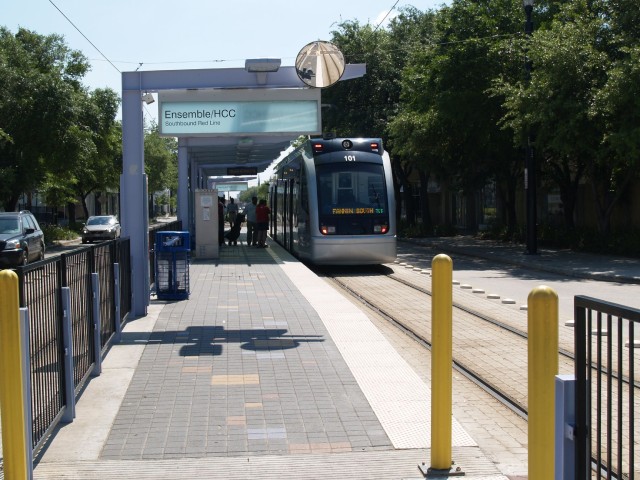CRITICAL
 Left-side boarding platforms require compatible vehicles, either LRVs, streetcars, or custom buses.
Left-side boarding platforms require compatible vehicles, either LRVs, streetcars, or custom buses.
Level or near-level boarding must be provided on median platforms. Center boarding stops are good candidates for fully level boarding, since route-specific vehicles are deployed in most cases.
On bi-directional platforms, 24-inch detectable warning strip must extend the length of the platform on both sides.
 Signage and pavement treatments, including markings or color, warn pedestrians to clear from unsafe waiting spaces.
Signage and pavement treatments, including markings or color, warn pedestrians to clear from unsafe waiting spaces.
If proof-of-payment fare payment is used, platforms may be open. Turnstile-controlled stations should be partially enclosed to control entry onto the platform, with openings located in alignment with vehicle doors
(see Fares & Boarding).
RECOMMENDED
 While the minimum accessible platform width is typically 8 feet, platforms serving both travel directions require wider platforms, especially at busier stations. 12 feet is the preferred minimum width (10 feet in constrained conditions), expanding as capacity increases. Platforms serving only one direction may be a minimum of 9 feet wide (including space for a railing along the rear of the platform).
While the minimum accessible platform width is typically 8 feet, platforms serving both travel directions require wider platforms, especially at busier stations. 12 feet is the preferred minimum width (10 feet in constrained conditions), expanding as capacity increases. Platforms serving only one direction may be a minimum of 9 feet wide (including space for a railing along the rear of the platform).
 Provide high-quality amenities like shelter, seating, schedules, real-time arrival, wayfinding, system information, and maps to nearby destinations.
Provide high-quality amenities like shelter, seating, schedules, real-time arrival, wayfinding, system information, and maps to nearby destinations.
Utilizing proof-of-payment systems and all-door boarding can improve on-time performance on high-traffic routes.
 A refuge island tip should be installed to provide pedestrians protection from vehicles. The pedestrian landing or refuge area must be large enough to accommodate peak passenger alighting volumes. Wider crosswalks (longer refuge areas) are the simplest way to achieve higher capacity. Provide bollards to prevent automobile use of this space for illegal movements.
A refuge island tip should be installed to provide pedestrians protection from vehicles. The pedestrian landing or refuge area must be large enough to accommodate peak passenger alighting volumes. Wider crosswalks (longer refuge areas) are the simplest way to achieve higher capacity. Provide bollards to prevent automobile use of this space for illegal movements.
OPTIONAL
In cold or rainy climates, stations may be enclosed to provide comfortable waiting space.
Integrate bicycling into transit access; provide bike parking within 50 feet of the platform entrance.
If bicycles are allowed on transit vehicles utilize signage and markings to direct bicycles to preferred doors. Separate bicycles from wheelchair areas on transit vehicles where possible.

Red Line LRT, Houston credit: (Christof Spieler)